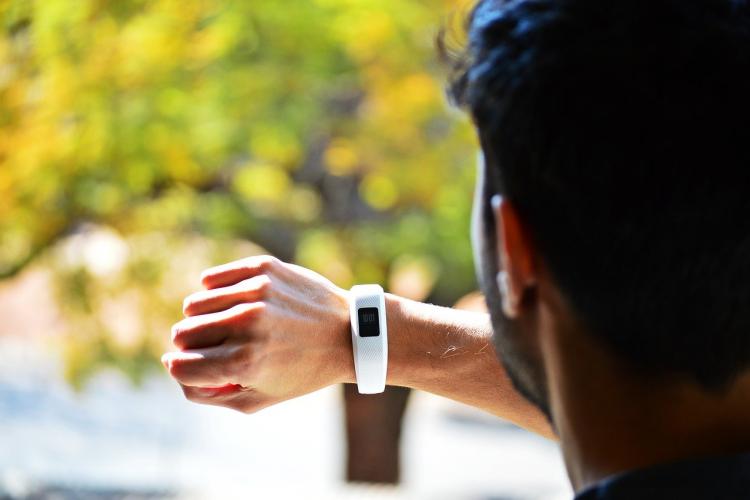The generic architecture of RADAR-base forms a reusable, flexible IT platform that allows for the remote monitoring of different diseases and conditions using a large variety of technologies.

The RADAR-CNS project is testing how practical and useful smartphones and wearables can be to continuously monitor the symptoms of people with major depression, epilepsy or multiple sclerosis. Long-term monitoring of patients with these kinds of chronic conditions is usually done two to four times per year in the clinic.
The proposition here is that you can generate much more - and much more valuable - data by using a combination of ‘passive monitoring’ (physiological data collected from a wearable like a FitBit) and ‘active monitoring’ (self-assessment questionnaires and tests done on a smartphone). Lower costs, higher volumes of data, and the ability to provide information to clinical teams and patients in real-time give the RADAR-CNS researchers hope that they can predict and maybe prevent relapses by detecting changes in physiology, behaviour, sleep, or mood before the individual themselves is aware of them. By studying the individual closely over time, it’s also possible to form a more personalised understanding of the disease and how these diseases vary over time.
Predict and prevent relapse
The team at King’s College London are behind the technical development of the platform and helping to understand how the incoming data relates to clinical outcomes. They’re working on extending RADAR-base functionality to incorporate new means of passive and active remote measurement while supporting a growing open-source community of code contributors and new studies adopting RADAR-Base. They’re also collecting information from patients, clinicians and regulators about barriers to its adoption in both research and clinical domains.
While the team has singled out three conditions to test the value of this kind of remote assessment, ultimately, they want to leave behind a data collection platform that is flexible enough that it can be used for other kinds of diseases, conditions and scenarios. New wearables for physiological monitoring are appearing on the market all the time, so the intention is to create a platform architecture that is generic and flexible enough to incorporate any new technology.
"By having the population connected to a network continuously, we are able to change the paradigm of how a disease can be observed"
Amos Folarin from King’s College London is one of the developers of the platform. He says, “It’s essentially a way to collect data continuously rather than episodically and looking at how the individual deviates from their baseline. This type of real-time population studies was not really possible prior to the widespread availability of smartphones, by having the population connected to a network continuously, we are able to change the paradigm of how a disease can be observed."
Plug and play
“The idea was to build a piece of software that would enable data collection remotely from a variety of sources: sensors, questionnaires and digital tests, from people going about their day-to-day lives."
“When we started there were only a few commercial providers of these kinds of platforms. We wanted something in the open research arena for researchers to freely use. We wanted to build software infrastructure for a type of data collection ‘highway’, leaving users free to explore how this could be utilised in various domains. We are deliberately broad in the types of data that we allow. This plug-and-play capacity has allowed several other projects to extend the platform and include additional sensor data or wearable devices, or have taken existing sensors and are using them in new ways. For example, using wearables to monitor respiratory infections in CoViD-19.”
The team were recently contacted to see if the platform could be used to monitor how well CoViD-19 patients were self-isolating. “That’s the challenge now – it’s not just about small cohort research studies. But that was always in the back of our minds when we designed this – we wanted to build something that would be scalable, both in terms of patient numbers as well as in terms of devices.”
A how-to for selecting the right device
Knowing which technology to use for remote assessment – and how to implement it - can be tricky. Validated ‘off-the-shelf’ devices for collecting high-quality patient data are sparse, and some patients are reluctant to wear clunky, hospital-grade devices due to stigmatisation. To help with this, RADAR-CNS have come up with guidelines, details of which were outlined in a paper published in May, based on human design principles that can help identify, test, select – and then put to use – off-the-shelf remote monitoring devices.
They call it a ‘human-centred approach’ to device selection. It guides study designers through stakeholder engagement, technology landscaping, rapid proof-of-concept testing, and creative problem-solving. The framework helped select devices for the RADAR-CNS study on relapse in multiple sclerosis, and can be useful for teams that need to consider patient experiences alongside scientific priorities and logistical, technical, or regulatory constraints.
The data generated by the RADAR-base platform is built on principles of clearly documented, structured and reusable data. This therefore enables projects using RADAR-base to comply with the FAIR principles and those we are involved with typically aim to make the data available in a public open access repository with unique identifiers, and accompanied by relevant metadata, in a standard format that will allow for interoperability.
Read more
RADAR-base platform for generalised data collection
When data is FAIR, citizens ultimately reap the benefit
From a few months to a few clicks
